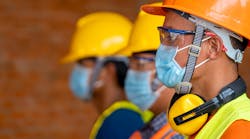It takes a leader to handle unprecedented challenges within the workplace, and the COVID-19 pandemic has shown the essential role of the safety leader. No longer are these professionals viewed as “cops,” but they now are looked at as arbiters of critical decisions that will keep businesses moving forward and employees safe as economic conditions fluctuate.
Just over 700 safety professionals recently participated in an EHS Today editorial survey in which they provided insight into how companies are managing the evolving business environment and what they think workplace safety will look like in the future.
While the majority of respondents represented the manufacturing (33.5%) industry, construction (11.4%), government (7.6%), and oil and gas (5.8%) were among the other industries represented.
The majority, 88.9% of those who took the survey, felt that their organization has been effectively supporting and communicating policies throughout the pandemic.
“Our president sent out weekly email updates, even if it was to just comfort employees and reinforce that their health comes first and we’re all in this together,” one respondent wrote. “The company took early measures and have put in place procedures that will protect our facilities as changes in the pandemic occur.”
Still, some safety professionals felt like executive leadership could have been more proactive in such a visible role and to act as a role model.
“There are measures in place,” one safety professional said. “In general, the measures are followed. However, senior management fails to lead by example as face masks are not worn.”
Whether or not the C-suite has been supporting efforts, safety professionals still need to step up as leaders in during this unprecedented time and practice emergency preparedness. More than half (58.7%) of respondents indicated that their EHS management program included policies and controls for infectious diseases/illness prevention prior to the COVID-19 outbreak.
As the pandemic reared its ugly head, respondents faced continuing challenges to their efforts, the biggest ones being cross functional management (22.5%), time (19%), and staggered phases (15.2%). Nearly 20% (19.66%) specified other obstacles, such as lack of adherence to new measures.
“There is a lot of pushback from employees. Some are scared to death others are not,” one safety professional explained. “Some employees have never stopped working or changed their job in any way. For example, a water utility worker cannot work from home. They feel this all crazy. The office worker likes working from home and doesn’t want to come to work. Because all they hear is how bad it is. If we can’t get back to work the economy is going to tank.”
Return-to-work efforts pose a test in business continuity efforts, with 44.7% of respondents saying it will take 1-3 months to get their entire workforce back to their facilities, 30% saying it will take 3-6 months and 8.3% saying it will take a year.
New procedures also have caused safety professionals to see an increase in expenditures, with 44.7% saying their budgets have increased in response to pandemic protocols.
Because of the uncertain public health environment, future operations will change to ensure workplace safety. Professionals gave a glimpse into the “new norm,” saying flexible work policies including work from home (50.6%), an increased emphasis on industrial hygiene and occupational health (49.8%), additional policies and controls (43%), and increased technology investment (18.9%) will support business continuity in the future.
One respondent concludes, “This pandemic should be a huge eye opener for everyone around the globe. I strongly believe that this will be the way of life going forward.”
The complete findings, sponsored by Intelex, will be presented during the August 18 webinar "How is the Safety Industry Evolving?"
